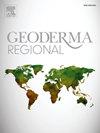Cover crop mixtures enhance belowground carbon input and suppression of spontaneous flora under Danish conditions
IF 3.1
2区 农林科学
Q2 SOIL SCIENCE
引用次数: 0
Abstract
Cover crop (CC) mixtures offer a unique set of advantages that can enhance soil health and agricultural productivity when compared to pure stand CC. However, a quantitative understanding of the varying contributions of different carbon (C) input pathways in CC mixtures is lacking. To address these gaps, a field experiment with multiple-pulse labelling with 13CO2 was used to quantify C-derived from CC mixtures via plant biomass, as well as via phyllo- and rhizodeposition. We assessed the impact of preceding main crops (barley, barley-pea, pea, and faba bean) on soil C input to 75 cm depth by two CC treatments (pure stand ryegrass versus a mixture of chicory, plantain, and ryegrass) and their effect on spontaneous flora (SF) biomass and diversity. In topsoil layers (0–25 cm), net C lost to soil via phyllo- and rhizodeposition was higher with mixed CC (30 g C m−2) than pure stand ryegrass (25 g C m−2). Between 25 and 75 cm, mixed CC and pure stand CC had similar C inputs via rhizodeposition despite larger root biomass in mixed CC. Cover crops reduced SF biomass and diversity, with mixed CC exerting the strongest suppressive effect, reducing biomass (individuals counted) by 57 % compared to the control. The improved efficiency of mixed CC was attributed to species complementarity in leaf and root patterns, resource utilization, and nutrient uptake. In conclusion, well-designed mixed CC had a greater positive impact on soil C inputs and suppression of SF compared to CC pure stand with ryegrass, resulting from complementary above and belowground traits.
丹麦条件下,混播覆盖作物可增加地下碳输入并抑制自发菌群
与纯立地CC相比,混播CC具有一系列独特的优势,可提高土壤健康和农业生产力。然而,目前还缺乏对 CC 混合物中不同碳(C)输入途径的不同贡献的定量了解。为了弥补这些不足,我们利用 13CO2 多脉冲标记法进行了一项田间试验,以量化 CC 混合物中通过植物生物量以及通过叶片和根茎沉积获得的碳。我们评估了两种 CC 处理(纯黑麦草与菊苣、车前草和黑麦草混合物)对 75 厘米深度土壤碳输入的影响,以及它们对自发植物群(SF)生物量和多样性的影响。在表土层(0-25 厘米),混合 CC(30 克 C m-2)通过植物体和根茎沉积流失到土壤中的净碳量高于纯黑麦草(25 克 C m-2)。在 25 厘米到 75 厘米之间,混合 CC 和纯立地 CC 通过根瘤沉积的碳输入量相似,尽管混合 CC 的根生物量更大。覆盖作物减少了 SF 的生物量和多样性,其中混合 CC 的抑制作用最强,与对照组相比,生物量(计数个体)减少了 57%。混合 CC 效率的提高归因于物种在叶片和根系模式、资源利用和养分吸收方面的互补性。总之,与黑麦草纯CC相比,设计良好的混合CC对土壤碳输入和抑制SF有更大的积极影响,这是地上和地下性状互补的结果。
本文章由计算机程序翻译,如有差异,请以英文原文为准。
求助全文
约1分钟内获得全文
求助全文
来源期刊

Geoderma Regional
Agricultural and Biological Sciences-Soil Science
CiteScore
6.10
自引率
7.30%
发文量
122
审稿时长
76 days
期刊介绍:
Global issues require studies and solutions on national and regional levels. Geoderma Regional focuses on studies that increase understanding and advance our scientific knowledge of soils in all regions of the world. The journal embraces every aspect of soil science and welcomes reviews of regional progress.
 求助内容:
求助内容: 应助结果提醒方式:
应助结果提醒方式:


